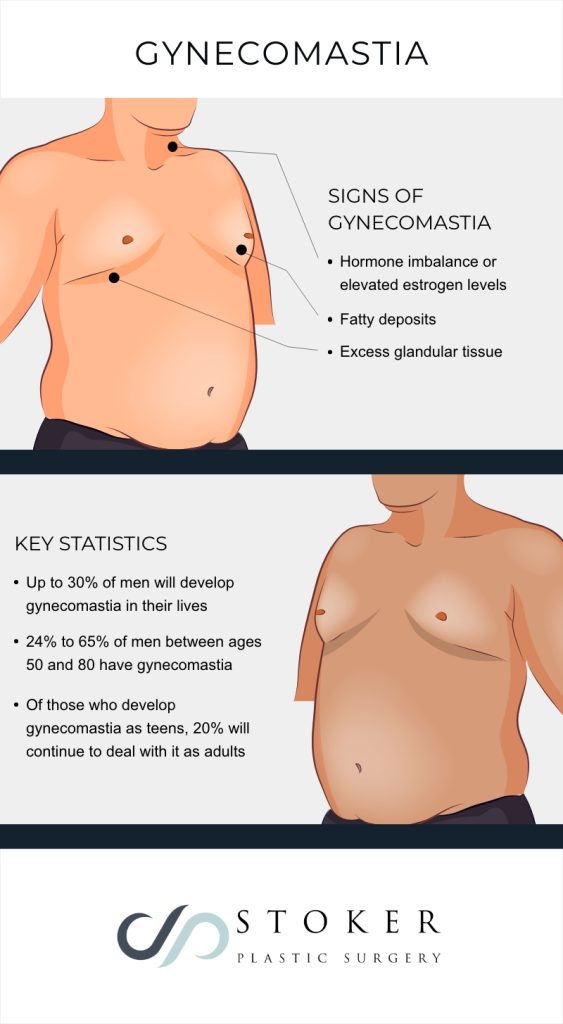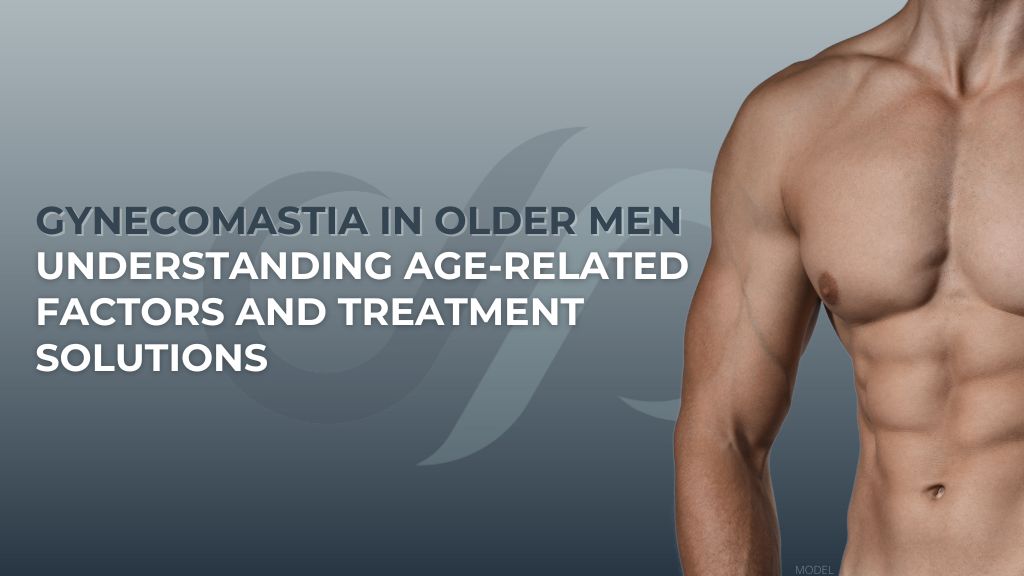Gynecomastia, characterized by enlarged male breast tissue, can affect men of all ages. While most common in young men going through puberty, it can also develop later in life, typically among men in their 50s to 70s. This guide covers the intricacies of gynecomastia in older men, explores treatment options, and highlights our practice’s expertise and sensitivity when addressing this cosmetic concern.
Gynecomastia Basics
More commonly known as “man boobs,” gynecomastia refers to the swelling or enlargement of male breast tissue, contributing to a more feminine chest appearance. It is often attributed to hormone imbalances, particularly a higher estrogen level than testosterone.
Gynecomastia is caused by excess glandular (breast) tissue, though fat can also contribute to a soft, rounded chest. However, when fatty tissue is the primary culprit, it is called pseudo-gynecomastia instead. Learn how to tell the difference between chest fat and gynecomastia in our related blog post.
Unique Factors Contributing to Gynecomastia in Older Men
As men age, a variety of factors can contribute to the development of gynecomastia or exacerbate existing cases. In fact, clinical research has estimated that up to 30% of men will experience gynecomastia at some point in their lives. In older men, this figure is closer to 70%. Contributing factors include:
Hormonal Changes
Testosterone levels naturally decline with age. This hormonal shift, coupled with relatively stable or increasing estrogen levels, can create a conducive environment for gynecomastia to develop.
Medications
Medications for age-related health conditions, such as prostate or heart issues, can mimic estrogen-like effects on the body. In turn, this can contribute to gynecomastia.
Weight Fluctuations
Maintaining a healthy weight becomes more challenging with age as the metabolism slows. With weight gain and increased body fat, men may experience elevated estrogen levels or develop pseudo-gynecomastia due to the accumulation of fat.
Underlying Health Conditions
Certain medical conditions become more prevalent with age and can impact the balance of hormones. Liver diseases, thyroid disorders, and even certain tumors can trigger gynecomastia.
Lifestyle Factors
Sedentary lifestyles, poor dietary choices, and excessive alcohol or marijuana consumption can all exacerbate gynecomastia or pseudo-gynecomastia risks.

Treatment Options for Male Breast Reduction
Male breast reduction is a transformative solution for men seeking to address gynecomastia and regain self-confidence. The procedure aims to remove excess breast tissue, fat, and skin (when gynecomastia is accompanied by significant weight loss and skin inelasticity) to create a smoother and more masculine chest contour.
There are two primary techniques for male breast reduction:
Liposuction
For pseudo-gynecomastia or cases where the excess breast tissue is accompanied by unnecessary fat, liposuction offers a targeted contouring option with minimal scarring. During liposuction, a thin cannula is inserted to break up and suction excess fat.
Surgical Excision
Although liposuction can help create a flatter chest profile in true gynecomastia cases, surgical excision of glandular tissue is the main remedy. This approach uses a scalpel to cut away the redundant breast tissue and create a firmer chest.
My Expertise in Gynecomastia Treatment
As an experienced board-certified plastic surgeon, I bring a wealth of experience and compassion to gynecomastia treatment. I deeply understand the physical and emotional challenges posed by gynecomastia and craft personalized treatment plans that address each patient’s unique needs.
My approach begins with a thorough consultation, during which I comprehensively evaluate the patient’s medical history and overall health. This meticulous assessment allows me to recommend the most appropriate treatment strategy, whether liposuction, surgical excision, or a combination of both.
More than technical expertise, my staff and I bring an empathetic approach to patient care. We understand how gynecomastia can impact a man’s self-esteem and body image, and we treat each patient with great respect and sensitivity. I take the time to educate patients about their condition, treatment options, and expected outcomes, enabling them to make informed decisions about their treatment.
Conclusion
Gynecomastia can be a source of distress for older men, affecting both physical and emotional well-being. However, understanding the age-related factors that contribute to gynecomastia and exploring effective male breast reduction options can lead to transformative results—such as the ones found in our before and after photo gallery.
Our practice’s extensive knowledge, expertise, and compassionate approach make Stoker Plastic Surgery a trusted partner for those seeking to reclaim their confidence and achieve a more masculine chest contour. If you or someone you know is navigating the complexities of gynecomastia, know that you’ll be guided by a skilled professional who values your unique concerns and desires. Remember, age is no barrier to achieving the appearance you deserve.
Please request a consultation or call us at (310) 300-1779 to get started.







Leave a Reply